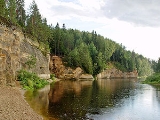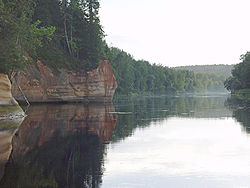
Gauja National Park
Encyclopedia

Vidzeme
Vidzeme is one of the historical and cultural regions of Latvia. Literally meaning "the Middle Land" it is situated in north-central Latvia north of the Daugava River...
is the largest national park in Latvia
Latvia
Latvia , officially the Republic of Latvia , is a country in the Baltic region of Northern Europe. It is bordered to the north by Estonia , to the south by Lithuania , to the east by the Russian Federation , to the southeast by Belarus and shares maritime borders to the west with Sweden...
, with an area of 917.45 km² running from north-east of Sigulda
Sigulda
Other twinnings: Keila, Estonia chiatura Georgia-References:* , , , , , and -External links:*...
to south-west of Cēsis
Cesis
Cēsis , is a town in Latvia located in the northern part of the Central Vidzeme Upland. Cēsis is on the Gauja River valley, and is built on a series of ridges above the river overlooking the woods below...
along the valley of the Gauja
Gauja
The Gauja is one of the longest rivers in Latvia, with a length of and a catchment area of . Its source is in the hills southeast of Cēsis. It first flows east and north and forms the border with Estonia for about . South of Valga and Valka, it turns west towards Valmiera, continuing southwest...
River, from which the park takes its name. It was established on 14 September 1973 and is thus also the oldest national park in Latvia. The park administration is based in Sigulda.
The park is particularly noted for the Devonian
Devonian
The Devonian is a geologic period and system of the Paleozoic Era spanning from the end of the Silurian Period, about 416.0 ± 2.8 Mya , to the beginning of the Carboniferous Period, about 359.2 ± 2.5 Mya...
sandstone
Sandstone
Sandstone is a sedimentary rock composed mainly of sand-sized minerals or rock grains.Most sandstone is composed of quartz and/or feldspar because these are the most common minerals in the Earth's crust. Like sand, sandstone may be any colour, but the most common colours are tan, brown, yellow,...
cliffs, in some places as high as 90 metres, along the banks of the Gauja. In the south-west it is mainly used by the inhabitants of Riga
Riga
Riga is the capital and largest city of Latvia. With 702,891 inhabitants Riga is the largest city of the Baltic states, one of the largest cities in Northern Europe and home to more than one third of Latvia's population. The city is an important seaport and a major industrial, commercial,...
as a leisure facility, while further to the north-east it is more strictly protected.
The area was formerly sometimes known as the "Livonian Switzerland" and tourists started to visit this area in the 19th century.
Besides the towns of Cēsis and Sigulda, Līgatne
Ligatne
Līgatne is a town on the Gauja River, in Latvia. The village of Līgatne was built around the paper mill, still extant, on the River Līgatne in the 19th century.-Līgatne Nature Trails:...
(with the Līgatne Nature Trails) is also located in the park, and Valmiera
Valmiera
Valmiera is the largest city of the historical Vidzeme region, Latvia, with a total area of 18.1 km². It is the center of the Valmiera District. As of 2002, Valmiera had a population of 27,323, and in 2008 – 27,569....
is close to it. It also includes Turaida Castle
Turaida Castle
Turaida Castle is a recently reconstructed medieval castle in Turaida, in the Vidzeme region of Latvia, on the opposite bank of the Gauja River from Sigulda....
, Lielstraupe (known for its church and castle) and the historic Ungurmuiža estate.
47% of the park's territory is forest, mostly spruce and pine, but including some deciduous growth. Of the numerous lakes in the park the largest is Lake Ungurs.
External links
- Gauja National Park website
- http://www.lacumiga.lv/en/index.htmlLacu miga (The bears' den) hotel and restaurant - LīgatneLigatneLīgatne is a town on the Gauja River, in Latvia. The village of Līgatne was built around the paper mill, still extant, on the River Līgatne in the 19th century.-Līgatne Nature Trails:...
] - Tourist trail in Gauja National Park 360 degree panorama

